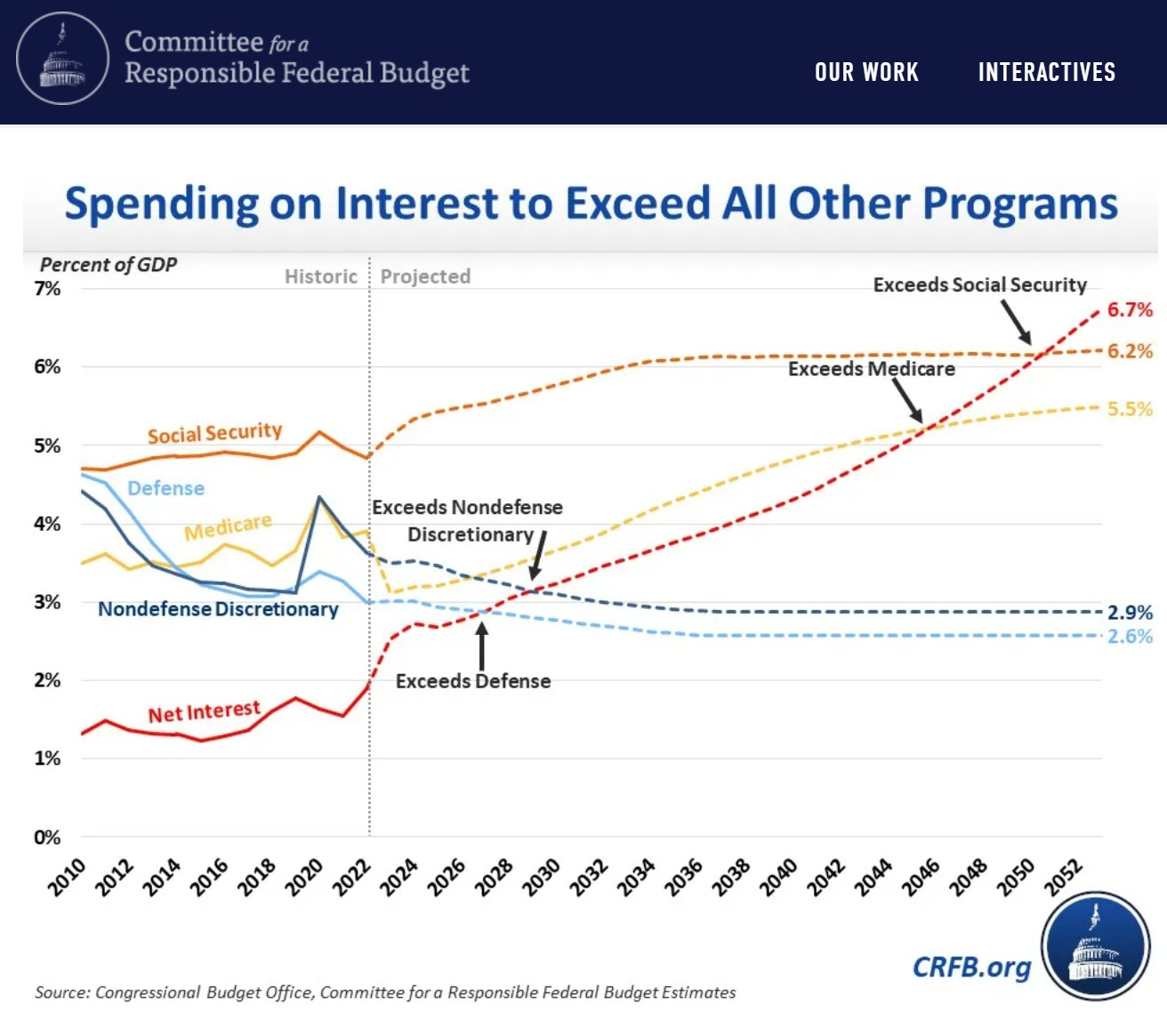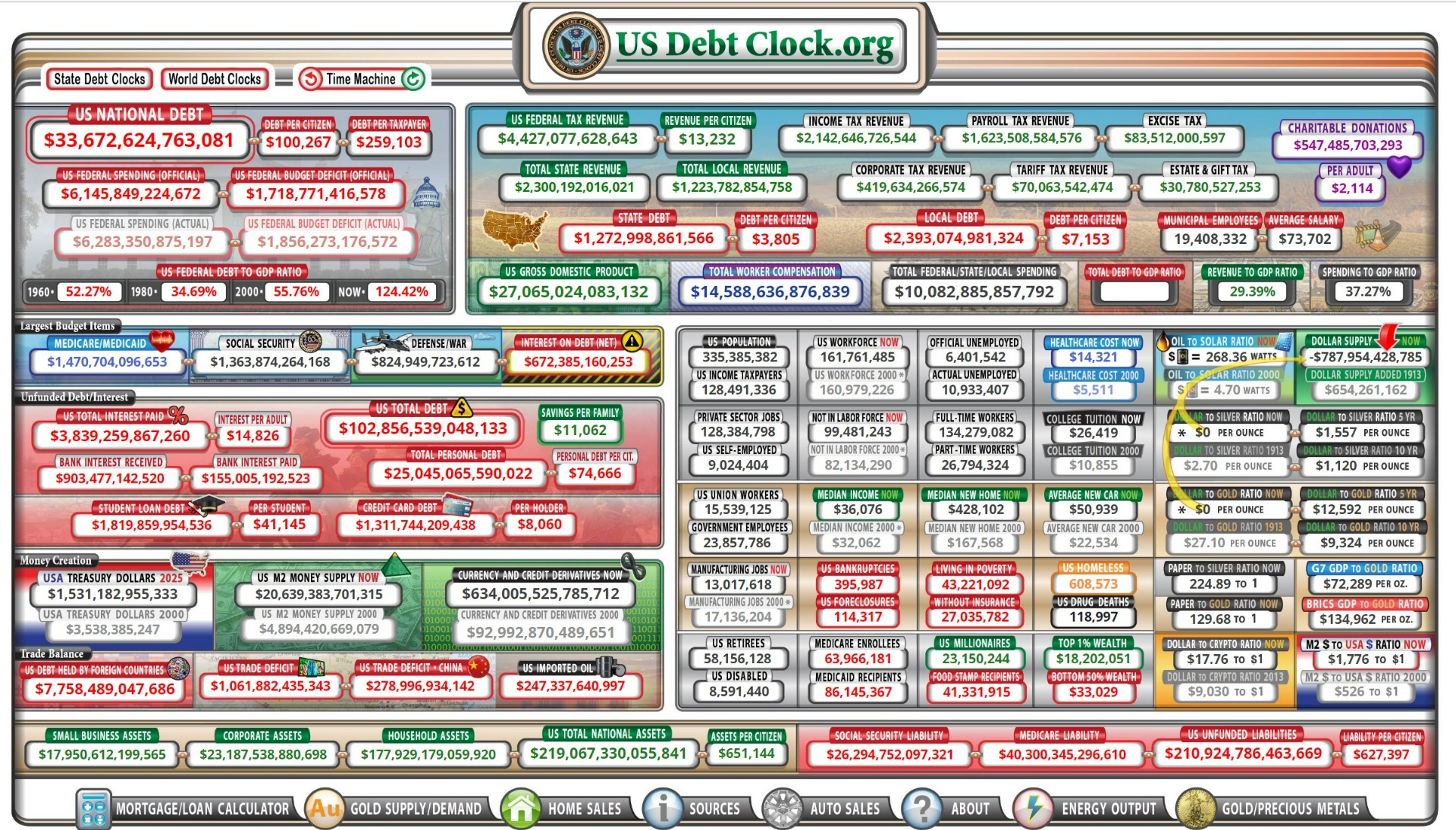The US national debt is spiraling out of control..
National Debt Emergency - Interest costs on the debt will slowly exceed defense and medical expenses.
The national debt of the United States is literally out of control - from 31.4 trillion dollars in June, it has increased by 2.18 trillion to more than 33.6 trillion.
It is clear that there is no way that the debt will be erased by 2025, but on the contrary, we will very likely see another sharp increase in spending, since the United States has already officially stated that it is ready to finance two armed conflicts.

So government spending still supports and will continue to support inflation. The same inflation that, on the other hand, the central bank is trying to reduce to the target rate of 2%, which is an unattainable goal under these circumstances, and so average Americans will continue to suffer.
But now it gets interesting - Interest..
But then, as interest rates began to rise, so did short-term Treasury yields, which in turn made federal borrowing more expensive.
And here's the problem - the government wants treasury revenues to rise so it can borrow more to finance its spending. The 10-year Treasury yield hit 4.914% last week, meaning government-issued debt is becoming more attractive to investors. However, this definitely has two sides - higher debt management costs, and at the same time the ability to finance growing expenses through even more borrowing.
That is, if the government spends most of its budget on interest payments, it will literally be unable and will stop supporting those programs that are vital to society. And this will immediately affect the quality of life and public services.
So let's start by saying that, according to the Committee for a Responsible Federal Budget (CRFB), in 2028, interest costs on the US national debt will exceed defense spending, just four years from now.
As interest rates rise, so does the cost of US government debt. Interest payments on the national debt will become the fastest-growing part of the federal budget over the next several decades, according to a report recently released by the Committee for a Responsible Federal Budget (CRFB).
The Committee further reports that net interest payments will reach a nominal dollar record of $475 billion in fiscal year 2022 and estimates that:
- by 2033, these payments will nearly triple to $1.4 trillion,,
- by 2043 they will rise to $2.7 trillion
- and to $5.4 trillion by 2053..
As a share of the economy, net interest will rise from 1.9 percent of GDP in fiscal 2022
- to a record 3.2 percent by 2030
- and will more than double to 6.7 percent by 2053
On the left side of the "United States Debt Clock" is a section titled "Largest Budget Lines" that lists these four":
- Health Care,
- Social Security,
- Defense/war,
- and the fourth largest expense is The Interest on the debt.
- 81 % of defense and war spending,
- 49% of social security spending,
- a 45 % health care spending..
According to the CFRB, by 2051 interest spending will already be the largest item in the federal budget, surpassing all others, including Social Security, health care, defense and war spending, and all other mandatory and discretionary spending programs. By the end of the next three decades, interest will consume 6.7% of GDP and 35% of annual federal revenue.
So one of the biggest problems with government spending right now is that the United States can no longer fund it.
Their tax revenues are falling, and the more problems consumers and businesses face, the more likely it is that the government will have less tax revenue in the future and we're in a vicious circle - the only way out is to keep borrowing.

The fact that interest spending is already practically at the same level as defense spending is a significant warning sign. Increasing debts for the purpose of armaments and wars is certainly not the way to go, and this applies to all countries. After a few years, it will naturally lead to a dramatic decline in the quality of life of people, education, services, health care, etc. And on top of that, of course, it will also have an impact on defense capabilities, as members of the House and senators voted for another increase in the budget and a new spending bill in the amount of another 106 billion dollars.

And the summary?
The United States embarked on a path of indebtedness that has already exceeded 130% of GDP, in a few years only spending on debt repayment will exceed defense costs, and in 30 years also on social and health care, and will thus become the highest cost item of the budget.. This amount, of course it detracts from the investment and development of the own state, which is associated with a lower quality of life and business. Then there is a decrease in tax collection, inflation and further indebtedness.
If the United States government doesn't do something drastic about it, the whole country is at risk of a long recession and slow decline. I doubt that the US will go bankrupt, but it will be a long gradual decline and the dollar will cease to be the main reserve currency.
Many countries have already understood this and are selling off American bonds in large quantities, reducing their share and linkage to the dollar currency and starting to trade in their own currencies.
Unfortunately, Europe and the European economy is dependent on the USA, so these impacts will be reflected practically parallel to our continent and, given the problems in the banking sector, with a high probability, they will be even more negative.
At least the next 2 years will be economically very demanding and uncertain, and therefore it is extremely important to prepare for them as much as possible. The only way to do this is the so-called diversification of the portfolio, property, using the Permanent Portfolio - to divide your property into three to four parts:
- Cash, stocks, bonds, pension funds, ..
- Real-estates
- Precious metals - gold, silber, platinum
- Vryptocurrencies - Bitcoin and Tthereum
Michal







